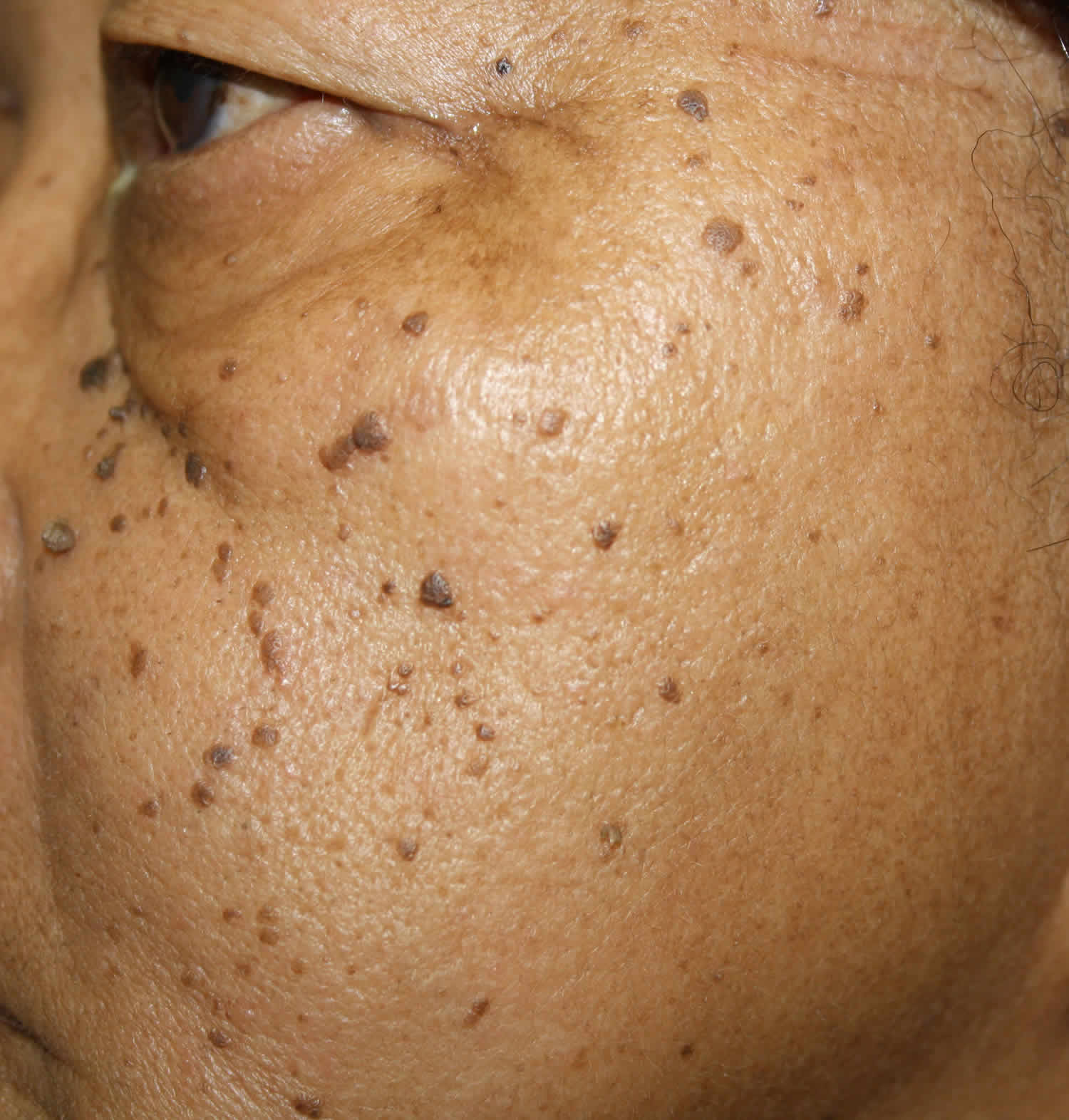What is dermatosis papulosa nigra
Dermatosis papulosa nigra is a harmless condition commonly affecting the faces of African-American, Afro-Caribbean and sub-Saharan black patients and sometimes Asian and Polynesian adults. Dermatosis papulosa nigra affects up to 35% of American blacks. There is a lower frequency in African Americans with a fairer complexion. Females are more frequently affected than males with a female:male ratio of 2:1. Dermatosis papulosa nigra describes the presence of multiple, small, 1–5 mm diameter, smooth, firm, black or dark brown papules on face and neck. Dermatosis papulosa nigra is considered a variant of seborrheic keratosis (senile wart), with an earlier age of onset in many cases, arising often in adolescence with lesions increasing in number and size after that. The cause of dermatosis papulosa nigra is unknown, although about half of people affected have a family history of the disease.
Dermatosis papulosa nigra affects up to 35% of people of African descent and an unknown proportion of individuals of Asian descent. Women are affected more than men. Dermatosis papulosa nigra usually begins in adolescence, and the number and size of lesions increase with age. The spots of dermatosis papulosa nigra do not go away.
Analogous to seborrheic keratosis, dermatosis papulosa nigra is a benign skin tumor without malignant potential. Because of the occasionally high number of lesions and the localization in visible areas, dermatosis papulosa nigra may be cosmetically disturbing and the patients will therefore wish to remove the multiple lesions.
No treatment is needed for dermatosis papulosa nigra lesions unless they are bothersome cosmetically.
When removal of dermatosis papulosa nigra lesions is sought, care must be taken to be conservative to avoid scars and loss of pigment in the skin.
Freezing (cryosurgery), scraping (curettage), and burning (electrocautery) are all effective removal methods.
Dermatosis papulosa nigra causes
The papules of dermatosis papulosa nigra are identical to small seborrheic keratosis. Dermatosis papulosa nigra is likely to be genetically determined with 40–50% of patients having a family history. It is believed to be due to a nevoid developmental defect of the hair follicle. Recently, FGFR3 mutations have been identified in dermatosis papulosa nigra. These mutations have been previously reported in seborrheic keratoses. The detection of FGFR3 mutations in dermatosis papulosa nigra further supports the concept that this lesion is indeed merely a variant of (acanthotic) seborrheic keratosis in darkly pigmented people.
Dermatosis papulosa signs and symptoms
Dark colored papules arise mainly on the cheeks and forehead but they may also be found on the neck, upper back and chest. Scaling, crusting and ulceration do not occur. The papules are symptomless but may be regarded as unsightly.
Numerous 1–5 mm firm, smooth, raised, dark brown to black bumps occur on the cheeks and forehead. Sometimes these bumps may also be on the neck and trunk.
- Mild – less than 10 spots
- Moderate – 10 to 50 spots
- Severe – more than 50 spots
Dermatosis papulosa nigra diagnosis
No tests are needed as dermatosis papulosa nigra is diagnosed clinically. If there is any doubt a skin biopsy can be taken. Histology shows a seborrheic keratosis with markedly increased pigmentation of the basal layer of the epidermis.
Dermatosis papulosa nigra treatment
Dermatosis papulosa nigra lesions are generally best left untreated. Complications of locally destructive treatment can include increased and decreased pigmentation, scarring and keloid formation.
Treatment choices include curettage, freezing with liquid nitrogen (cryotherapy) and electrodessication followed by curettage. Nd:YAG laser has also recently been reported to achieve excellent cosmetic results. Treatment is kept superficial to minimize the risk of complications.





